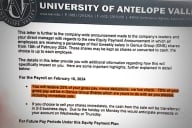You have /5 articles left.
Sign up for a free account or log in.
WASHINGTON -- That sound you heard Friday at 5:15 p.m.? That was the collective thud of the heads of for-profit college executives hitting their desks in dismay when they got a first look at the sort of loan repayment data the U.S. Education Department expects to use in its proposed new regulatory scheme, aimed at ensuring that vocational programs prepare their graduates for "gainful employment."
The numbers were lower than many observers (supporters and critics of the for-profit college sector alike) expected, and while officials of the companies immediately disputed the legitimacy of the department's data and again challenged the government's underlying regulatory approach, they also seemed to recognize that the statistics presented yet another threat. One company, Strayer Education, went so far as to schedule a news conference for 7:30 a.m. today -- before the stock markets open -- to explain, and presumably contest, the department's numbers for its campuses.
Department officials couched the mountain of information they released Friday -- the equivalent of a doctoral dissertation in statistics, it seemed to this under-educated reporter -- in a slew of caveats, noting the many ways in which it is either incomplete or preliminary or otherwise inappropriate for reaching too-sharply-drawn conclusions, particularly about the eligibility of individual institutions or their programs.
That was especially true for the information related to two of the three measures the department proposes, which are designed to reveal whether the median debt loads of students who completed a given program in the three previous fiscal years are at or below what the department considers a reasonable percentage of their annual earnings or discretionary income.
While the department released several tables and reports to explain how its officials calculated those debt-to-income ratios, the complexity of those calculations, and the fact that they will be dependent on income and earnings data about students that most colleges do not have, mean that the income ratios largely remain an enigma.
The data released by the department do not provide 100 percent clarity about the other major "gainful employment" measure: the extent to which recent students repay their loans. Most notably, the information provided Friday looks at the performance of entire institutions, rather than of specific academic programs, which is how the department ultimately plans to make its assessment.
But despite those caveats, the numbers released by the department were almost certainly lower and, therefore, more troubling than had been predicted (and not just for for-profit colleges, but more on that later).
The mechanism for measuring programs' loan repayment success -- which ensures that a program will remain fully eligible for federal student aid if at least 45 percent of its recent enrollees are repaying the principal on their student loan debt -- was generally seen, by opponents and defenders of the department's regulatory proposals alike, as the easiest of the various tests for a program to meet. (Programs with loan repayment rates under 35 percent would be ineligible to participate in the federal aid programs, unless they have one of the acceptable debt-to-income ratios; programs with rates between 35 and 45 percent would face some restrictions.)
Interested in For-Profit Higher Ed?
Visit our "In Focus" page,
which features articles on
the policy environment, enrollments
and partnerships with nonprofit
colleges, among other topics.
If the loan repayment test is the "easy" one, and if the institution-wide numbers released Friday are at least a reasonable indication of how a for-profit college's individual programs would ultimately fare in the government's proposed system, a whole lot of commercial colleges could find themselves in serious trouble -- including many that were generally expected to do well because they've historically had comparatively low cohort default rates for their students.
But as they dug into the numbers that the department released Friday, officials at many for-profit colleges said it became increasingly clear to them that the way the department is calculating loan repayment rates is destined -- if not designed -- to make them look worse than they really are.
That is primarily, they said, because the department's chosen calculation counts as non-repayers many borrowers who participate in several programs aimed at protecting financially distressed borrowers. Department officials had already made clear in the original Notice of Proposed Rule Making that borrowers who had sought forbearances or deferments on repaying their loans would be counted as not repaying their loans. (Note: This paragraph has been updated to correct an error.)
But what disturbed officials at several for-profit colleges was that the department's proposed method of calculating repayment rates also seemed to penalize institutions if their borrowers had taken advantage of two other programs that the Education Department has aggressively promoted as legitimate alternatives: income-based repayment and loan consolidation.
The apparent treatment of borrowers in all those categories as non-payers meant that numerous colleges that considered themselves to be in relatively good shape under the loan repayment part of the proposed gainful employment system may very much not be, if the department's current approach stands.
Strayer University had a comparatively low 6 percent cohort default rate in the federal government's last report on the proportion of borrowers who were unable to repay their loans within two years of entering repayment, and its officials, in conducting their own analysis of available Education Department data in recent weeks, said the information suggested that between 55 and 60 percent of borrowers with original (as opposed to consolidated) loans were repaying the principal on them.
Company officials said as much in a conference call with investors two weeks ago, with Robert Silberman, the CEO and chairman, saying that "our preliminary internal analysis using the extensive data we have collected on our students and alumni over the last 10 years, indicates that under this purposed [sic] regulation all our programs would comfortably pass both the 45% loan repayment test and the debt to income ratio test, placing all our programs in the department’s highest category or full title for eligibility with no required debt warning disclosures."
But the data released by the department on Friday evening showed Strayer's repayment rates hovering in the low 20s, and set off an intense search by company leaders for an explanation. A team of Strayer analysts, "literally working through the night," Silberman said in an interview Sunday afternoon, determined that the department had counted as being not in repayment "virtually every single one of the nearly two-thirds of our total student loans" that had been consolidated. In other words, the consolidated loan holders were counted in the denominator but not in the numerator, driving the rate down.
Strayer officials, via an e-mail from Silberman to Education Secretary Arne Duncan, requested an urgent meeting with department officials, and in a telephone conversation Saturday, Silberman said, the agency's administrators confirmed that the complex computer program they had run to calculate the loan repayment rate had excluded all consolidated loans on which borrowers were not repaying principal -- even if those borrowers' loan agreements did not require them to repay principal, and if the borrowers were in good standing on their loans.
"We have a hard time understanding how people can be current on a product that the department itself has itself approved, and then hold that against the university," Silberman said. "How can that make sense?"
Clearly worried about the impact the data might have on the company's stock price, which like many shares of for-profit colleges has taken a pounding in recent months, Strayer scheduled a call for investors at 7:30 this morning, before the markets open.
Officials at Kaplan Inc. expressed a similar, if broader, concern about the department's approach, noting that colleges were being punished for borrowers who were taking advantage of options (loan consolidation, income-based repayment, deferments and forbearances) specifically designed to help them.
"There are four programs that the government has developed, sponsors and promotes to assist economically disadvantaged and challenged students with loan repayment, but student borrowers that employ those programs are punitively assessed in the government's definition of repayment," said Matt Seelye, chief financial officer at Kaplan. "Schools are penalized for having students in those programs," even though they're perfectly legal and even, in many cases, encouraged.
Late Sunday, Education Department officials responded via e-mail to the concerns raised by Strayer and others. Borrowers with consolidation loans and those in income-contingent repayment are "considered successful if their loan balances are smaller at the end of the year than the beginning," Justin Hamilton, a spokesman, said via e-mail. "The idea here is that the traditional default rate does not capture borrowers who may be meeting their legal obligations but are economically unable to pay off their loans. Students can avoid default by staying in touch with their lender but that does not mean their loan burden isn't causing economic hardship."
Hamilton added: "Over the past two decades, schools have learned to manipulate their default rate calculations. One strategy some schools use is encouraging likely defaulters to consolidate. As a result including consolidation loans may have a big impact on some schools."
Supporters of the department's approach said it is logical for the government to include only those borrowers who are making significant progress toward repaying their loans, as measured by the fact that they are eating into the actual loans by paying down the principal.
If colleges have been maintaining low default rates because significant numbers of their students are in one way or another deferring repayment -- advocates for consumers have often accused some for-profit colleges of manipulating their default rates by not-so-gently encouraging their students into forbearances or deferments, to keep them out of the two-year window in which default rates have been measured -- that "is going to catch up with them" given the Education Department's proposed approach on loan repayment rates," said Debbie Frankle Cochrane, a program director at the Institute for College Access and Success.
Cochrane notes that the department's gainful employment measure, if ultimately put in place, would exclude borrowers who have military or in-school deferments and loans awarded through the government's public service loan forgiveness program. The loan repayment data that the department released on Friday did not account for borrowers with public service forgiveness, which could bring down the rates for institutions with significant numbers of students in teaching, nursing or other professions that would qualify for such treatment.
Beyond the For-Profit Colleges
The department's proposed gainful employment regulations would apply only to the most programs at for-profit colleges and to non-degree vocational programs at nonprofit colleges, and various analyses of the loan repayment data the department released on Friday show that for-profit institutions, as a group, have by far the lowest loan repayment rates. As is often the case, though, what's not entirely clear is why.
Cochrane, of the Institute for College Access and Success, noted in a blog post late Friday that the department's data showed only 36 percent of students at for-profit institutions to be paying off the principal on their loans, compared to 54 percent of students at public institutions and 56 percent at independent nonprofit colleges. (Community colleges, she noted in an interview, had a 40 percent rate.)
Mark Kantrowitz, publisher of Finaid.org and a serious number cruncher, cuts those numbers another way, to ask a sort of (probably unanswerable) chicken and egg question: Do those institutions have lower loan repayment rates because of the quality and value of the programs they offer (as the government seems to suggest), or because of the types of students they enroll?
Institutions that enroll few low-income students have generally very high rates: those with fewer than 10 percent Pell Grant recipients have an average loan repayment rate of 66.3 percent, Kantrowitz said, compared to a 38.3 percent rate at colleges with between 40 and 50 percent Pell Grant recipients.
"The concern is that the institutions that do a better job of serving or attracting Pell Grant recipients are going to be the ones that are negatively impacted" by the government's proposed approach, Kantrowitz said, while acknowledging the flipside argument that those institutions might be exploiting students if few of them can repay their educational loans.
While the data published by the Education Department might pose risk at this point only for for-profit colleges, given how the agency plans to carry out its gainful employment rules, the statistics are unlikely to have been well-received at all nonprofit colleges. For the 89 historically black colleges in the department's Excel spreadsheet, according to one estimate, the mean loan repayment rate was 20 percent, and a full 93 percent fell below the 35 percent threshold that would make for-profit colleges ineligible for aid under the department's scheme.
And while the department reports a lowly 16 percent loan repayment rate for for-profit Devry Inc.'s Ross University School of Medicine, it is in some pretty good company. Harvard Medical School and Tulane University's medical school both show a rate of 24 percent, and the University of Chicago's Pritzker School of Medicine clocks in at 22 percent.
As a Republican Congressional aide put it Sunday in discussing the department's approach: "If this analysis makes sense for the for-profits -- if we've decided loan repayment rates are a good way of assessing institutions -- I think you'll increasingly see Congress asking why it doesn't make sense for all types of institutions."









